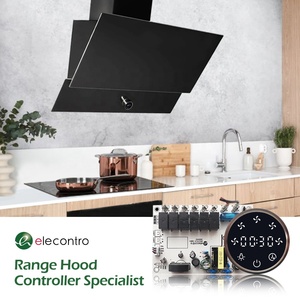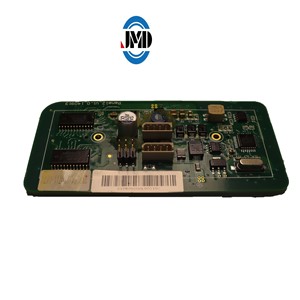
All categories
Featured selections
Trade Assurance
Buyer Central
Help Center
Get the app
Become a supplier

(3500 products available)

















































Single-Sided Button Circuit Boards
This is the most common type of PCBs. In single-sided circuit boards, all active components will be soldered onto one side while the conductive pathways or tracks are on the other side. This is the simplest and most basic form of a button circuit board. It's practical for products requiring basic functionality.
Double-Sided Circuit Boards
As the name suggests, double-sided circuit boards can have components on both sides of the circuit board. This increases the available real estate for more complex circuitry. Using a double-sided configuration enables the incorporation of additional buttons or features where space is limited.
Multilayer Button Circuit Boards
Multilayer circuit boards feature more than two layers. They are used in highly complex electronic systems that require dense circuitry. In multilayer boards, the internal layers can facilitate more complex button configurations and integrations with other components; hence, they are usually applied in advanced technologies like smartphones and medical equipment.
Flexible Button Circuit Boards
Flexible circuit boards can bend and fold. It's designed for applications in which the structure can be dynamic or different designs are required due to space constraints. Flexible circuit boards are often found in wearable technology, handheld devices, and products where the design will be non-rigid.
Rigid-Flex Circuit Boards
As the name suggests, rigid-flex circuit boards combine features of rigid and flexible circuit boards. This allows the circuit board to be bent to fit into complex enclosures while retaining rigid sections for stable components soldering. Rigid-flex circuit boards are prevalent in advanced electronics that necessitate both flexibility and durability.
Conductive Button Circuit Boards
These are intended specifically to provide pathways for electricity conduction. The conductive circuit layers make it possible to transfer electronic signals between circuit components effectively.
Consumer Electronics
In this industry, operation control and functionality input require button circuit boards. Button circuit boards are critical in this industry, for example, in navigating menu systems, adjusting the volume, or turning devices on and off. Depending on the requirements such as size, complexity, and durability, manufacturers will choose between flexible or multilayer boards.
Automotive Industry
Internal and external buttons are prevalent in modern vehicles. The automotive industries use button circuit boards to control their functions. For instance, these circuit boards will be applied for climate control systems, infotainment units, navigation systems, and even for safety features such as airbags and anti-lock braking systems.
Medical Devices
To ensure reliability and compliance with strict healthcare regulations, circuit boards for buttons used in medical devices must meet high standards. In medical devices such as pacemakers, infusion pumps, and diagnostic equipment, button circuit boards play key roles. Further, given the nature of their use, these boards should be highly durable, sensitive, and accurate, as well as provide stable functionality.
Industrial Machinery
Here, the circuit boards are used in control panels for machines. This allows users to manipulate operations, set parameters, and perform safety controls. In this industry, button circuit boards are typically designed to be very robust. This is a result of the circuit boards' exposure to harsh industrial environments and frequent use.
Home Appliances
In washing machines, refrigerators, and microwaves, it's common to find buttons that are controlled by circuit boards. The function of these circuit boards is to enable users to control settings, start or stop operations, and interact with digital displays. Depending on the appliance type, these circuit boards may be either single-sided, double-sided, or multilayer.
Telecommunications
Button circuit boards provide various control functions in this industry. Button circuit boards control, for example, signal transmission, system activation, and network settings interaction in complex devices like routers, mobile phones, and satellites. Circuit boards for buttons in telecommunications devices are required to support a sophisticated set of functions.
The features of button circuit boards include:
For most button circuit boards, conventional thickness is 1.6 mm. Nevertheless, flexibility designs may vary significantly in thickness.
The normal copper layer thickness is 1 oz/ft2. This can, however, change depending on the current requirements.
Standard surface finish for circuit boards with buttons is HASL or ENIG. This, however, depends on application and customer preference.
Usually, the aspect ratio of multilayer boards is kept at a minimum of 8/1. High-end circuit board button designs can have higher aspect ratios.
Usually, the dielectric substrate material used in these circuit boards is FR-4. However, for flexible circuitboards, polyimide will be used.
The sole purpose of the button circuit boards is for users to communicate with electronic devices. For instance, in consumer electronics, these circuit boards are primarily used in mobile phones, tablets, and other gadgets.
In IoT products, button circuit boards are used for simple data transmissions and device activations.
Button circuit boards help control appliances like refrigerators and washing machines.
These circuit boards are key in enabling safety measures, for example, in fire alarms and emergency stop systems.
In medical devices, these circuit boards keep clean and interactive control systems for their users.
The lifespan of button circuit boards can be prolonged through proper repairs and circuit board maintenance practices. Some things to do when maintaining these systems include:
To avoid excessive wear, ensure that the buttons are pressed correctly. When excessive pressure or wrong angles are applied to the buttons, the circuit board connected beneath it can crack or become damaged. Educate users to apply modest pressure when the buttons are pressed to reduce physical damage over time.
Button circuit boards are normally enclosed to protect them. However, in case of water, dust, or other foreign object penetration, it can cause malfunction. Immediately wipe off spills and clean off any accumulated dust will help preserve the circuit board.
Excess heat, humidity, and extreme cold are all possible hostile environments to circuit board components. Keep their surroundings in a standard acceptable operating range to reduce deterioration.
At times, the solder joints connecting the buttons to the circuit board can crack or weaken, causing misfires or total functionality loss. Checking and re-solder those joints whenever they begin to show wear can prevent this from happening.
Ensure that the circuit board area is free from debris and build-up. This may cause overheating and even hinder functionality.
Periodic inspections mean identifying problems before they escalate. This will also ensure minimal disruption of services.
Frequent testing of these systems can identify malfunctioning components. Further, testing will allow one to replace them in advance without affecting end users.
Material Selection
Good-quality circuit boards are made from durable and reliable materials. FR-4 epoxy resin and flexible polyimide are commonly used materials for these circuit boards. These materials have great electrical insulating capabilities and mechanical strength.
Layer Configuration
The right level of complexity needed for the application will determine the layer configuration for the circuit board. Manufacturers of multilayer boards use advanced techniques like blind/buried vias to increase their conductivity and density.
Component Sourcing
Use high-grade electrical components. For example, high-quality tactile switches, resistors, and capacitors will ensure that the board works well.
Soldering Quality
Soldering will, however, be done by a professional while maintaining high standards. Poor quality soldering will lead to cold joints, solder balls, and bridging, which will affect functionality.
Manufacturing Standards
When circuit boards are manufactured under formal guidelines, they are of superior quality. Examples of these manufacturing standards are IPC-A-600 and IPC-6012.
Testing and Certification
Quality assurance through rigorous testing is key in ensuring circuit boards meet the required performance and safety standards. Look for certifications indicating compliance with regional and international safety and quality standards.
Electrical Safety
One of the key components of ensuring the safety of users is ensuring that the circuit boards are well contained and insulated. Short circuits, overheating, and electrical shocks may all result from poor insulation or damaged circuit boards. Voltage ratings and board design compatibility should be matched to ensure electrical safety.
Thermal Management
Overheating can damage circuit boards and components, leading to potential fires. Proper ventilation, heat sinks, and design for efficient thermal dissipation are critical in avoiding overheating.
Chemical Resistance
Some components may be affected by chemical exposure. For instance, corrosion may occur. Ensure that the materials used in the board and the components are resistant to chemicals that may be in the surrounding environment or that the board may come into contact with.
Electromagnetic Compatibility (EMC)
Buttons circuit boards may interfere with the operations of other electronic devices connected to them. This is as a result of electromagnetic interference (EMI). This, therefore, requires that manufacturers put in place measures to control EMI. They can do this by using shielding, proper grounding, and placement of components.
Regulatory Compliance
Ensure that the button circuit boards comply with hazardous materials and RoHS regulations. Lead and mercury are hazardous substances that can affect human health and degrade the environment.
A1: This is an important electronic component that allows users to interact with and control devices through simple input methods. Common applications include consumer electronics, home appliances, and vehicles. Button circuit boards are found in these spaces because they provide a user-friendly interface and allow businesses to create reliable and intuitive products.
A2: Apart from the buttons themselves, there are also conductive traces that form electric pathways button circuit boards. The traces connect the buttons to the device's main circuit. Circuit boards have insulating layers between the conductive traces, preventing unwanted electrical contact. Lastly, there is a protection coating over the board that ensures the circuit board protection from moisture, dust, and mechanical damage.
A3: First, they are durable and can be designed to withstand frequent operation. There are several finishes available, including gold immersion, lead solder, and HASL (Hot Air Solder Levelling). They are suitable for low power applications. Manufacturers often use eco-friendly processes and materials to produce the circuit boards. Finally, they are cost-effective since they are produced in bulk.
A4: Firstly, keep the area around it relatively cool. After that, regularly inspect it for dust or foreign objects penetration and remove them if found. Thirdly, ensure that whenever the solder joints connecting the buttons to the circuit board weaken, one has it checked and re-soldered. Finally, one should perform regular electronic testing to identify malfunctioning components early.
A5: They ensure that circuit boards comply with international hazardous substances and RoHS regulations. They also select and use materials that are safe and have a low impact on the environment, like lead-free solder and halogen-free laminates. Additionally, they use É contribute materials with high thermal stability to prevent overheating during circuit board operation.